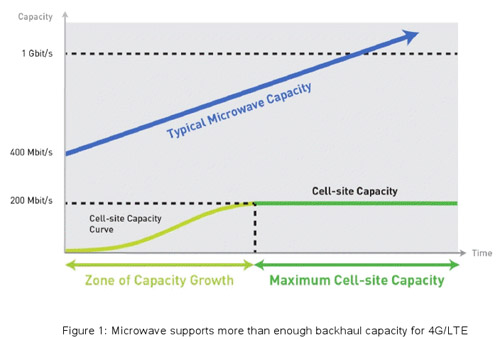A Realistic Look at 4G Backhaul Needs
Instead of taking a top down approach to understand 4G backhaul needs (based upon peak
theoretical download speeds, numbers of users, and so on), it is more instructive to look at what
the technology is actually able to support.
The backhaul requirements for a cell are fixed by a number of factors, regardless of how
many users there are in that cell. Network congestion and frequency interference will limit the
throughput achievable to rates well below the advertised peak rates. For a typical three sector
macro cell operating in the maximum 20MHz channel bandwidth, the total backhaul capacity
needed will be below 200 Mbit/s, even with the future introduction of LTE Advanced (Release
10). For the current Release 8 of LTE now being deployed, and with smaller operating channels
of 5 or 10 MHz, the actual backhaul capacity needs will be more often in the 10’s of Mbit/s, not
the 100’s.
Microwave Meets LTE Backhaul Capacity Needs
Taking a more realistic view of the backhaul requirements for LTE, it is clear that the
presumption that fiber can be the only logical solution from a capacity point of view doesn’t
make sense. As shown by Figure 1, modern microwave transmission systems more than meet
the capacity needs of 4G/LTE, with significant room to spare.

Licensed microwave operating in frequency bands between 6 and 40 GHz has formed the basis
of most mobile backhaul networks around the world for the past 20 years, apart from in the US
with its heavy reliance on copper leased lines. Innovative new microwave technologies have
been introduced to the market in the past few years that dramatically increases the throughput
capacity. The move to packet-based transport has also enabled a new range of Ethernet/IP-
aware products that are able to intelligently and dynamically utilize the available microwave
backhaul spectrum up to 3 or 4 times more efficiently than older TDM-based systems.
Microwave can easily support throughputs of 1 Gbit/s or more with fiber-like reliability.
Techniques such as the use of ring/mesh network architectures mean that microwave is
not only suitable as a last mile connection for cell sites, but is also able to support network
connections further into the access network where traffic is aggregated from multiple sites.





